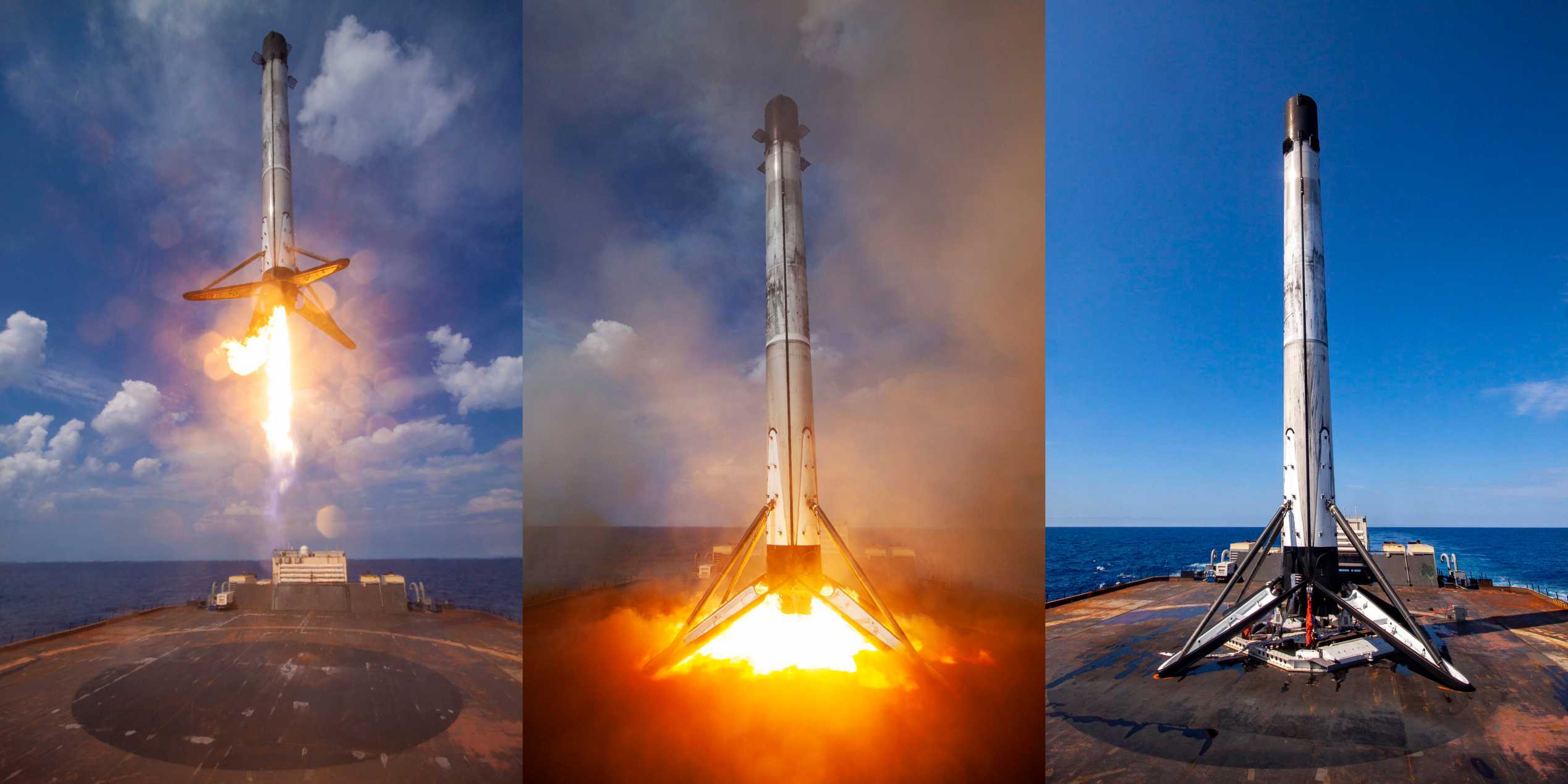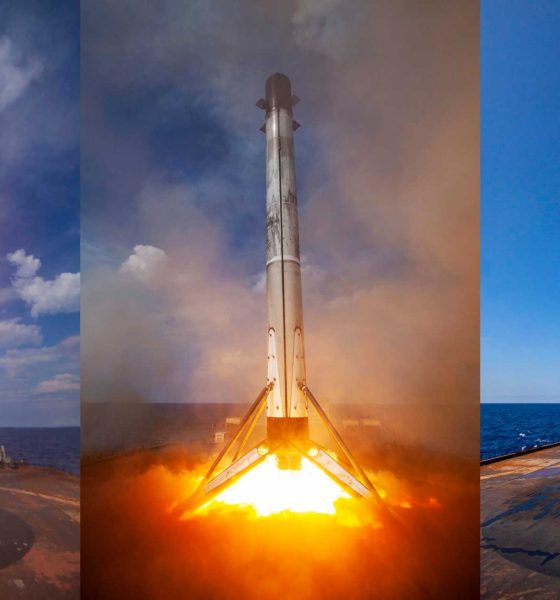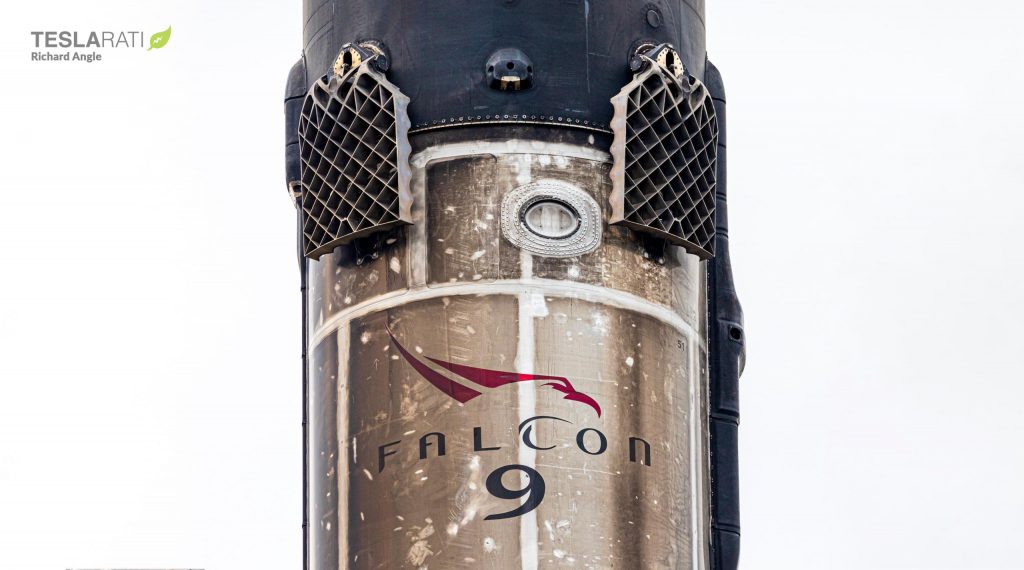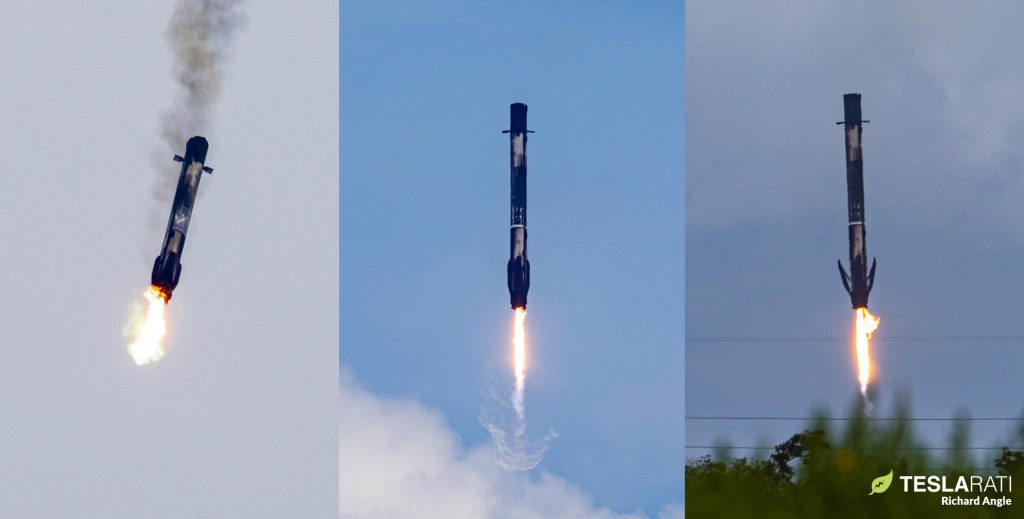

News
SpaceX prepares Falcon 9 booster for eleventh launch and landing [webcast]
SpaceX has confirmed that Falcon 9 is on track to launch another batch of Starlink satellites less than 48 hours after a successful United Launch Alliance Atlas V from a pad just two miles south.
Falcon 9 is now scheduled to launch Starlink 4-9 from Kennedy Space Center (KSC) Launch Complex 39A no earlier than (NET) 9:35 am EST (14:35 UTC) on Thursday, March 3rd. Oddly, unlike Starlink 4-8, which successfully launched 46 Starlink satellites into low Earth orbit (LEO) on February 21st, Starlink 4-9 – following a seemingly identical trajectory – will carry 47 satellites. The reason for the small difference is unclear.
Last month, SpaceX suffered a significant anomaly when a “geomagnetic storm” warmed Earth’s atmosphere, causing 38 of 49 just-launched Starlink 4-7 satellites to prematurely reenter and burn up. In response, while SpaceX hasn’t officially confirmed the change, it appears that all subsequent Starlink missions are being launched to slightly higher parking orbits. In comparison, Starlink 4-4 – a West Coast mission – launched 52 satellites into a 340 x 210 kilometer (210 x 130 mi) parking orbit in December 2021. Starlink 4-7, an East Coast mission, launched 49 satellites into a 336 x 210 km parking orbit on February 3rd, losing three satellites to account for extra performance needed to safely dodge the Bahamas.
Following Starlink 4-7’s space weather calamity, SpaceX – using an identical trajectory – launched 46 Starlink 4-8 satellites (three fewer than 4-7) from the East Coast into a higher 337 x 325 km parking orbit on February 21st. On February 25th, SpaceX also launched 50 Starlink 4-11 satellites (a reduction of two) from the West Coast into a higher 316 x 306 km parking orbit. In short, after Starlink 4-7, SpaceX appears to be sacrificing a few Starlink satellites to launch to parking orbits that are slightly higher and thus slightly more stable.

In theory, this should entirely prevent a repeat of the Starlink 4-7 anomaly while only marginally increasing the amount of time it should take dead-on-arrival satellites to reenter. While doing so increases the number of satellites Falcon 9 can launch, the main reason SpaceX launches Starlink satellites to such low orbits is to ensure that any failed satellites reenter a matter of days to a few weeks after launch instead of the years it could take at their operational ~550 km (~340 mi) orbits.
Of course, that doesn’t explain why Starlink 4-9 is projected to launch one more Starlink satellite than Starlink 4-8. It’s possible that SpaceX is refining its new insertion orbit on the fly and that Starlink 4-9 is headed to a slightly lower destination after data gathered from 4-8 and 4-11. It’s also possible that SpaceX is tweaking some other aspect of Falcon 9’s mission profile or even modifying Starlink satellites (i.e. adding or subtracting mass) – neither of which would be out of the ordinary for the company.
Regardless, Starlink 4-9 is interesting for a few more reasons. First, it will mark drone ship Just Read The Instruction’s (JRTI) first recovery mission since a mistake made by its onboard Octagrabber rocket nearly lead to the loss of an entire Falcon 9 booster in December 2021. That implies that SpaceX has fully determined and rectified the cause of that anomaly and repaired both the drone ship and its robot. To reach its full launch cadence potential, SpaceX needs at least two operational drone ships on the East Coast. Otherwise, in lieu of rare low-performance missions that allow Falcon 9 boosters to fly back to land, SpaceX can only launch one East Coast Falcon 9 mission every 10 or so days and can’t support Falcon Heavy launches that require two at-sea booster landings.



Additionally, SpaceX has confirmed that Falcon 9 B1060 will launch Starlink 4-9. The mission will be its 11th launch and landing attempt, hopefully making it the third Falcon 9 booster to successfully support 11 orbital-class launches after B1051 and B1058. Together, that means that 3 (15%) of the 19 Falcon 9 Block 5 boosters SpaceX has debuted will have singlehandedly supported 33 (37%) of the 89 Falcon 9 launches the company has completed since May 2018. It’s difficult to imagine a more resounding affirmation of SpaceX’s work on reusability.
Tune in to SpaceX Starlink 4-9 webcast around 9:20 am EST (14:20 UTC) on Thursday, March 3rd to watch the launch live.

News
Tesla starts showing how FSD will change lives in Europe
Local officials tested the system on narrow country roads and were impressed by FSD’s smooth, human-like driving, with some calling the service a game-changer for everyday life in areas that are far from urban centers.

Tesla has launched Europe’s first public shuttle service using Full Self-Driving (Supervised) in the rural Eifelkreis Bitburg-Prüm region of Germany, demonstrating how the technology can restore independence and mobility for people who struggle with limited transport options.
Local officials tested the system on narrow country roads and were impressed by FSD’s smooth, human-like driving, with some calling the service a game-changer for everyday life in areas that are far from urban centers.
Officials see real impact on rural residents
Arzfeld Mayor Johannes Kuhl and District Administrator Andreas Kruppert personally tested the Tesla shuttle service. This allowed them to see just how well FSD navigated winding lanes and rural roads confidently. Kruppert said, “Autonomous driving sounds like science fiction to many, but we simply see here that it works totally well in rural regions too.” Kuhl, for his part, also noted that FSD “feels like a very experienced driver.”
The pilot complements the area’s “Citizen Bus” program, which provides on-demand rides for elderly residents who can no longer drive themselves. Tesla Europe shared a video of a demonstration of the service, highlighting how FSD gives people their freedom back, even in places where public transport is not as prevalent.
What the Ministry for Economic Affairs and Transport says
Rhineland-Palatinate’s Minister Daniela Schmitt supported the project, praising the collaboration that made this “first of its kind in Europe” possible. As per the ministry, the rural rollout for the service shows FSD’s potential beyond major cities, and it delivers tangible benefits like grocery runs, doctor visits, and social connections for isolated residents.
“Reliable and flexible mobility is especially vital in rural areas. With the launch of a shuttle service using self-driving vehicles (FSD supervised) by Tesla in the Eifelkreis Bitburg-Prüm, an innovative pilot project is now getting underway that complements local community bus services. It is the first project of its kind in Europe.
“The result is a real gain for rural mobility: greater accessibility, more flexibility and tangible benefits for everyday life. A strong signal for innovation, cooperation and future-oriented mobility beyond urban centers,” the ministry wrote in a LinkedIn post.
News
Tesla China quietly posts Robotaxi-related job listing
Tesla China is currently seeking a Low Voltage Electrical Engineer to work on circuit board design for the company’s autonomous vehicles.

Tesla has posted a new job listing in Shanghai explicitly tied to its Robotaxi program, fueling speculation that the company is preparing to launch its dedicated autonomous ride-hailing service in China.
As noted in the listing, Tesla China is currently seeking a Low Voltage Electrical Engineer to work on circuit board design for the company’s autonomous vehicles.
Robotaxi-specific role
The listing, which was shared on social media platform X by industry watcher @tslaming, suggested that Tesla China is looking to fill the role urgently. The job listing itself specifically mentions that the person hired for the role will be working on the Low Voltage Hardware team, which would design the circuit boards that would serve as the nervous system of the Robotaxi.
Key tasks for the role, as indicated in the job listing, include collaboration with PCB layout, firmware, mechanical, program management, and validation teams, among other responsibilities. The role is based in Shanghai.
China Robotaxi launch
China represents a massive potential market for robotaxis, with its dense urban centers and supportive policies in select cities. Tesla has limited permission to roll out FSD in the country, though despite this, its vehicles have been hailed as among the best in the market when it comes to autonomous features. So far, at least, it appears that China supports Tesla’s FSD and Robotaxi rollout.
This was hinted at in November, when Tesla brought the Cybercab to the 8th China International Import Expo (CIIE) in Shanghai, marking the first time that the autonomous two-seater was brought to the Asia-Pacific region. The vehicle, despite not having a release date in China, received a significant amount of interest among the event’s attendees.
Elon Musk
Elon Musk and Tesla AI Director share insights after empty driver seat Robotaxi rides
The executives’ unoccupied tests hint at the rapid progress of Tesla’s unsupervised Robotaxi efforts.

Tesla CEO Elon Musk and AI Director Ashok Elluswamy celebrated Christmas Eve by sharing personal experiences with Robotaxi vehicles that had no safety monitor or occupant in the driver’s seat. Musk described the system’s “perfect driving” around Austin, while Elluswamy posted video from the back seat, calling it “an amazing experience.”
The executives’ unoccupied tests hint at the rapid progress of Tesla’s unsupervised Robotaxi efforts.
Elon and Ashok’s firsthand Robotaxi insights
Prior to Musk and the Tesla AI Director’s posts, sightings of unmanned Teslas navigating public roads were widely shared on social media. One such vehicle was spotted in Austin, Texas, which Elon Musk acknowleged by stating that “Testing is underway with no occupants in the car.”
Based on his Christmas Eve post, Musk seemed to have tested an unmanned Tesla himself. “A Tesla with no safety monitor in the car and me sitting in the passenger seat took me all around Austin on Sunday with perfect driving,” Musk wrote in his post.
Elluswamy responded with a 2-minute video showing himself in the rear of an unmanned Tesla. The video featured the vehicle’s empty front seats, as well as its smooth handling through real-world traffic. He captioned his video with the words, “It’s an amazing experience!”
Towards Unsupervised operations
During an xAI Hackathon earlier this month, Elon Musk mentioned that Tesla owed be removing Safety Monitors from its Robotaxis in Austin in just three weeks. “Unsupervised is pretty much solved at this point. So there will be Tesla Robotaxis operating in Austin with no one in them. Not even anyone in the passenger seat in about three weeks,” he said. Musk echoed similar estimates at the 2025 Annual Shareholder Meeting and the Q3 2025 earnings call.
Considering the insights that were posted Musk and Elluswamy, it does appear that Tesla is working hard towards operating its Robotaxis with no safety monitors. This is quite impressive considering that the service was launched just earlier this year.








